‘A resource for the nation’
Published in Book Reviews, Features, Issue 2 (March/April 2010), Volume 18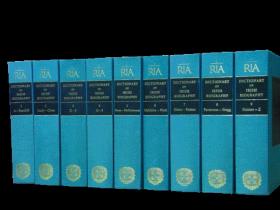
The nine volumes of the DIB contain eight million words in 9,014 entries covering 9,700 lives. (RIA)
The Dictionary of Irish Biography (DIB) is a superb achievement. The editors, James McGuire and James Quinn, conceive of the DIB as ‘a resource for the nation’ and it measures up to that exacting mark. It contains eight million words in 9,014 entries covering 9,700 lives (the Oxford Dictionary of National Biography [ODNB] has 3,500 Irish entries). The DIB ranges from the Huguenot refugee Jacques Abbadie to Zozimus, the Liberties balladeer, and from people who never existed (Cú Chulainn) to people who died in 2002—the most recent entry being Dorothy Walker, the art critic.
The DIB began slowly as an under-resourced pilot project in 1983 (an account of its genesis by its first editor, G. L. Herries Davies, appeared in Eighteenth-Century Ireland in 1987). The stirrings of the Celtic Tiger can be seen in the revamped project of the 1990s. A new editorial team was installed in 1992 under James McGuire, Ronan Fanning and Aidan Clarke. Bill Davies, commissioning editor of Cambridge University Press (CUP), agreed to publish the DIB, which then became a collaboration between the Royal Irish Academy (RIA) and CUP, with CUP agreeing to carry the production costs. The Higher Education Authority only agreed to fund the project in 1997 when it was clearly viable, and once the tiger was roaming the four—or three—green fields. Although it would be churlish not to acknowledge the handsome job that CUP has done, that is the context for the otherwise puzzling decision to ignore Irish publishers, including the RIA itself (especially given its recent populist rebranding), Four Courts, Cork University Press, Lilliput and others who have served Irish scholarship well over recent decades.
Compared with the slow bicycle race of the New History of Ireland series, the DIB has appeared with Usain Bolt-like speed. That is a tribute to the impressive managerial skills of the editors, James McGuire and James Quinn, deploying patience and diplomacy in marshalling such a wide array of contributors. And they have delivered this challenging project while retaining the loyalty and affection of the Irish scholarly community.
Politicians best represented
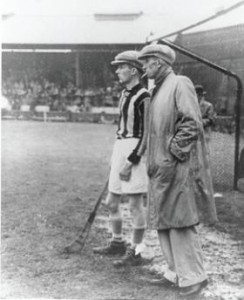
There are 442 sports-related entries, including Kilkenny hurler Lory Meagher, seen here (c. 1940s) giving a word of advice to Kilkenny goalkeeper Jim Dermody. (GAA Oral History Project)
Of the 10,000 subjects (the wider database was of 60,000 and the website will eventually list the unfortunate 50,000 who missed out), it seems easiest to make the cut if you were a politician. Eighty per cent of viceroys and chief secretaries are included—including several nonentities. Since 1921 every cabinet minister (but mercifully not every TD and MP), North and South, gets an entry. A few kings of England—Richard II, William III and James II—make it, but if you were an English politician you only feature if you were an Irish office-holder. That leads to the inexplicable omission of Gladstone but the inclusion of Balfour and Peel (a rather unsatisfactory entry that twice describes Daniel O’Connell solely as an ‘agitator’). After politicians, the military, at 829, are the second highest category. Figures like INLA man Dominic McGlinchey and the H-block hunger strikers are also included. Lawyers at 616 appear over-represented in comparison with 606 business people (including Jefferson Smurfit Sr, Denis Guiney and John Sisk). Medics occupy the next place with 525, followed by 492 in journalism and broadcasting. Perhaps surprisingly, sports comes next with 442 entries, ranging from golfer Harry Bradshaw to jockey Pat Taafe, soccer players Shay Brennan and Liam Whelan, hurlers Lory Meagher, Christy Ring and Nicky Rackard, and Norma Stoker (who excelled at hockey, tennis and badminton). There are a fair few boxers, always a sport in which Ireland punched above its weight. The ‘Gorgeous Gael’ Jack Doyle managed affairs with the automobile heiress Delphine Dodge, her fifteen-year-old daughter and her sister-in-law: the males of the Dodge family eventually prised him away from their women via threats at gunpoint and a $10,000 pay-off. Serial contributors Paul Rouse, William Murphy and Jim Shanahan have done a fine job in expanding the DIB range in this category, a pleasing innovation. The theatre and film world gets 416 entries, outpacing the 400 science and technology entries.
One of the pleasures of browsing the DIB is that one can assemble subsets of entries where the whole is greater than the sum of the parts: C. J. Woods and James Quinn on the 1790s, Linde Lunney on the Ulster-Scots ‘rhyming weavers’, and an excellent series (primarily by Aidan Breen) on Irish-language Continental scholars: Zimmer, Zeuss, Sjoestedt, Windisch, Sommerfelt, de Jubainville, Meyer, Thurneysen, Marstrander and Pedersen. Is the story that Marstrander vaulted over Tomás Ó Criomhtháin’s house with an oar apocryphal?
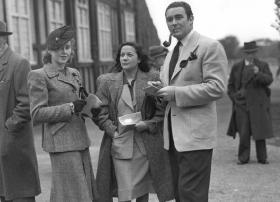
There are a fair few boxers, including the ‘Gorgeous Gael’ Jack Doyle, who managed affairs with the automobile heiress Delphine Dodge, her fifteen-year-old daughter and her sister-in-law: the males of the Dodge family eventually prised him away from their women via threats at gunpoint and a $10,000 pay-off. (RTÉ Stills Library)
Ten per cent of the entries cover people born outside Ireland, as well as Irish-born whose careers were overseas. This broad category ranges from the Polish-born Joseph Coen, president of the Dublin Hebrew Congregation, to the American gangsters ‘Chicago May’ (Mary Ann Duignan) and Vincent ‘Mad Dog’ Coll from Gaoth Dobhair. Tangentially Irish figures like Francis Bacon and Iris Murdoch, who had essentially English careers, are included but not Ned Kelly, although his Jerilderie letter is the apex of the Irish threatening-letter genre. The DIB bar was certainly set higher for the diaspora: many Irish-born bishops and nuns with distinguished careers are missing. Tipperary-born James Louis O’Donel of Newfoundland makes the cut, but Kilkenny man William Phelan, equally important in Cape Breton, is ignored, as is the hugely significant Waterford-born Michael Anthony Fleming in Newfoundland.
The DIB will be parsed for its treatment of Irish-language figures. It is surprising to find Seatrún Céitinn still appearing under ‘Geoffrey Keating’—and his (very competent) entry is far too short. The entry on Merriman still shocks in reminding us how little we know of his life: perhaps it could have mentioned Seamus Heaney and Ciarán Carson among significant translators of the Cúirt. James Cotter, Nicholas Sheehy and Art Ó Laoghaire are covered but not Muicheartach Óg Ó Súilleabháin, despite the exemplary study of him in 1997 by Pádraig Breatnach. All four are the subject of many eighteenth-century poems and to leave one of them out unbalances their treatment.
Women
Inevitably, the DIB will be closely scrutinised for its coverage of women. It peaks in the second half of the twentieth century at close to 20%, but it is only half that for earlier periods. By comparison, women comprise 10% of ODNB entries. Exemplary figures are included who might not have made it otherwise: Averill Deverell, for example, one of the first two women called to the Irish Bar in 1921, and the five-year-old Nellie Organ, a cause for beatification in the early twentieth century. Subjects can be lucky or unlucky in their contributors. A rather underwhelming entry on Biddy Early suffers by comparison with the sophisticated one on Bridget Cleary by Angela Bourke. Reading the entry on Joyce, one is struck by the stabilising and utterly admirable support that Harriet Weaver, Adrienne Monnier and Sylvia Beach offered him in his peripatetic and troubled life.
Music
Figures from traditional Irish music are in general well served. There are fine entries, for example, on Maggie Barry, Luke Kelly and Johnny Doran. It is salutary to be reminded how precarious was the life that tradition-bearers endured until very recently: Colm De Bhailís died in a workhouse; Johnny Doran was crippled when a derelict wall fell on his caravan; Seosamh Ó hÉanaí worked as a New York elevator attendant for fourteen years. The musical spectrum ranges wide, from Phil Lynott and Rory Gallagher to Frank Patterson, Butch Moore and Hugo Quinn.
Contributors
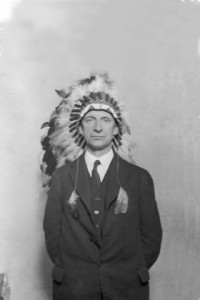
Éamon de Valera in Wisconsin, 18 October 1919, where he was made chief of the Chippewa tribe. The ‘Long Fella’ gets the longest entry (14,000 words), by Ronan Fanning. (UCD Archives)
Eighty-five per cent of entries in the DIB are by in-house contributors. The other 15% are longer entries on the better-known figures. Ronan Fanning contributes the longest entry (14,000 words) on de Valera (Collins gets short shrift—a mere 5,000). Fanning also supplies other lengthy—too lengthy—entries on Seán Lemass and Jack Lynch. Other long and underwhelming entries are on James Joyce and the duke of Ormonde. There is a twentieth-century bias to long entries—e.g. Neil Blaney, J. J. O’Kelly, Peter Berry, Ernest Blythe. Some entries are abrupt—200 words—mainly on medieval figures; most entries fall within the 800–1,000-word category. The 700 contributors span an admirably broad range, from Mr Justice Adrian Hardiman, social justice campaigner Peter McVerry, public servant T. K. Whitaker and politician Garret Fitzgerald to distinguished historians Joe Lee, Aidan Clarke (his precise essay on Peter Talbot is a gem) and Patrick Corish (on Nicholas French—on whom he first published in 1949). There are scintillating entries on Pearse by Joe Lee (the best in the entire DIB), O’Connell by Gearóid Ó Tuathaigh and Tone by Tom Bartlett, balanced by rather pedestrian ones on Connolly, de Valera and Casement. Michael Hopkinson on Collins is the most revisionist exercise: ‘He had a surer grasp of the limitations of his achievements than many of his biographers’. Hopkinson suggests that it was the British who inflated the Collins legend: he himself apparently endorses Mark Sturgis’s view that Collins was like ‘a provincial cattle dealer with a penchant for bad jokes’, happier with a card index than a revolver.
The editors obviously made commendable efforts to attract a broad range of historians (and the number of dead historians who have entries is also striking) but that may not hold true for other fields of scholarship. Literary scholars who contributed include Ann Saddlemyer and Angela Bourke, but neither rising stars like Joe Cleary or P. J. Mathews nor senior figures like Seamus Deane, Terry Eagleton or David Lloyd appear. There are too many nondescript entries on literary figures by historians. Humdrum entries on Lady Gregory and Charles Maturin, for example, do not compare in quality with those by Declan Kiberd on Synge, Colm Tóibín on Francis Stuart, Seán Ryder on Mangan or Robert Welch on George Moore. In general the DIB entries are better attuned to recent trends in historical than in literary or cultural scholarship. For example, consider the old-fashioned entry on the critic Richard Ellmann by Diarmaid Ferriter. Modern scholarship has taken a turn against Ellmann’s claim that Joyce’s birth in Dublin was ‘a vulgar accident’ and has reinstated a decisively Irish Joyce in place of the Ellmannesque cosmopolitan. It is not a historian, however, but a literary scholar who manages to name Beckett’s hand problem as Dupuytren’s contracture but not that he came from a Protestant family. As Beckett himself phrased it: ‘I’m a dirty low church P[rotestant] even in poetry’.
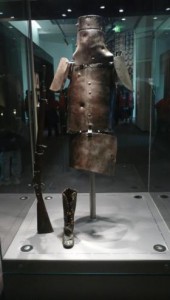
Ten per cent of the entries cover people who were born outside Ireland and whose careers were overseas—but not Irish-Australian bushranger Ned Kelly, whose armour is on display in the State Library of Victoria.
In the case of Irish people, their afterlives can be at least as controversial as their sober biographies. Perhaps it would have been wise in an Irish dictionary of biography to devote more extended treatment to these matters. Cú Chulainn is a hugely resonant figure but his entry makes no mention of his literary treatment by Lady Gregory, Yeats and Eimar O’Duffy, his influence on Pearse, nor his presence in the greatest livre-d’artiste that this country has produced—the Dolmen edition of Thomas Kinsella’s The Táin with illustrations by Louis Le Brocquy, nor his surprising reincarnation in loyalist murals. It would have been helpful to extend the bibliographic/sources section, offering explicit guidance. Cormac Bourke’s fine entry on St Patrick is the only one with an extensive treatment of sources. That reticence can be frustrating: we sense that Patrick Geoghegan doesn’t much like Ruan O’Donnell’s take on Emmet; ditto with Michael Hopkinson re Tim Pat Coogan and Peter Hart on Collins; and Hiram Morgan re Nicholas Canny on Hugh O’Neill.
In terms of editorial conventions, there are irritants. These include an anachronistic hangover from the old DNB—ending entries with anticlimactic commentary on images of the subject. Strict adherence to the Irish Historical Studies straitjacket generates relentless and often inconsistent non-capitalisation: after a while, it is just tedious to have the text pockmarked with usages like Dublin castle, dáil, Abbey theatre, the peace process, Rockwell college, catholic emancipation, the treaty, the republic, house of keys, special criminal courts, etc.
Politicians command the longer entries, and surprisingly short entries are devoted to Edmund Spenser, Charles O’Conor, Lady Morgan, William Drennan, Edmund Ignatius Rice, Patrick Sarsfield, John O’Donovan, Seán Ó Ríordáin and William Petty—all the subject of recent renewed scholarly interest. Impressive entries include those on Raiftearaí by Ciarán Ó Coigligh, JKL by Thomas McGrath, Pugin by Rhona Kennealy, Conrad Arensberg by Patrick Maume, John Kelly by Sylvie Kleinman, Charles McGuinness by Ferghal McGarry, Joseph Rafferty by Michael Ryan, Christy Ring by John A. Murphy and Dennis Taaffe by Manuela Ceretta. Among disappointing ones are those on Edmund Burke, John Toland, George Sigerson, Estyn Evans, Caoimhín Ó Danachair and George Ogle. Of the in-house team, the entries by Lawrence William White are consistently the most impressive. There are, too, the inevitable errors, but these are predominantly venial.
The editors would be the first to acknowledge that their efforts build on many significant scholarly efforts of this kind. These include the Beatháisnéis series, the History of Irish Parliament, the Companion to Irish traditional music, the Guide to Irish fiction 1650–1900, Lost lives, Field Day Anthology, Dictionary of Irish philosophers, Dictionary of the Dublin book trade, the Collected Tone and Letters of W. B. Yeats.
Last major project in hard copy?
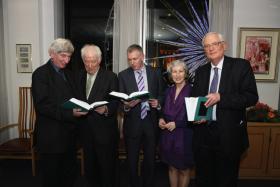
Seamus Heaney (second from left) launching the DIB in the Ulster Bank headquarters, Belfast, on 16 December 2009, with (left to right) Nicholas Canny (president of the RIA), James Quinn (executive editor), Linde Lunney (editorial secretary) and James McGuire (managing editor). (RIA)
Inevitably, too, new work has appeared that expands our knowledge of particular subjects. A superb monograph by Pádraig de Brún, Scriptural instruction in the vernacular, contains by far the most detailed treatment we have ever had of Thady Connellan, John O’Daly and many other minor figures. Similarly, existing entries would need to take account of John Andrews’s study of the cartographer Richard Bartlett, Roger Ekirch’s elegant Kidnapped on James Annesley, and the meticulously researched biography by R. W. Lightbowm of that strange creature the earl of Aldborough. And is an entry on Archbishop Dermot Ryan that fails to mention child abuse now acceptable? (In fairness, there are entries on the evil Brendan Smyth and Seán Fortune.) The need to update will be addressed on-line: the DIB intends to issue two on-line supplements containing 40 lives annually. That is a reminder that this nine-volume DIB is quite probably the last time that a major project like this will appear in hard copy as well as web form. All in all, the DIB is an indubitable milestone in Irish scholarship, and an absolutely outstanding achievement for its editors. No Library can be without it. HI
Kevin Whelan is Director of the Keough Naughton Notre Dame Centre, Dublin. He contributed the entry on Lord Edward Fitzgerald to the DIB.
















